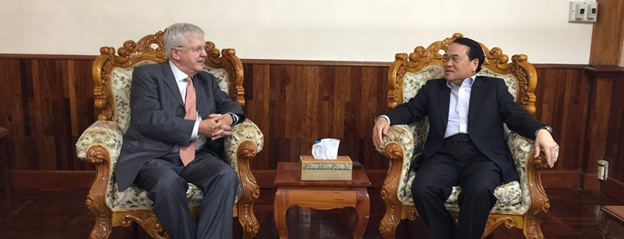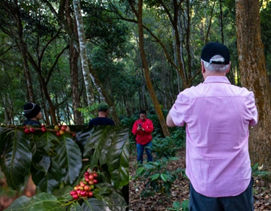Dr. John Robinson, WCS Executive Vice President for Conservation and Science visited Lao PDR from December 9 to 16, 2019. During his visit, Dr. Robinson met with His Excellency Thongphat Vongmany, Vice Minister of Agriculture and Forestry to highlight the progress made by Lao PDR toward managing and protecting wildlife and protected areas through on-going institutional, legal and regulatory reforms. Dr. Robinson and H.E. Vongmany discussed the close partnership between Lao PDR and WCS, and emphasized the importance of institutionalizing protected area systems and strengthening law enforcement in Lao PDR. While in Vientiane, Dr. Robinson also met with WCS Laos staff to understand better about various landscape and cross-cutting programs of WCS Laos, discuss the value, opportunities and challenges WCS is recognizing in Lao PDR and within the context of the Mekong Region, and for staff to gain Dr. Robinson’s insights into the institutional evolution of WCS Global Conservation Program and how WCS Laos can work toward being a ‘flagship’ country program.

Dr. Robinson with HE Thongphat Vongmany
He also travelled to Nam Et-Phou Loeuy National Park (NEPL NP), one of the national flagship conservation landscapes that WCS Laos co-manages with the Government and the People of Laos for almost two decades. NEPL received legal status of “National Park” in February 2019, one of the only two national parks currently existing in Lao PDR. This represents the accumulative efforts of partnership between the Government and WCS Laos.
Dr. Robinson explored NEPL through the award-winning community-based ecotourism programmes—the Nam Nern Night Safari (NNNS) and the Phou Louey Trekking Tour—which create a direct link between the increase of wildlife populations and an increase in community income and incentives. Through these eco-tourism products, more than 150 local villages have been trained as field guides, boat operators, porters, cooks and maintenance personal and are currently employed on a rotational basis. They receive remuneration from the income generated through these tours. 26 villages associated with these two products receive annual incentive fund bonuses based on the amount of wildlife seen on the tours. As a result, wildlife observations during tours have increased from an average of four sightings per tour in 2010 to an average of 11 sightings per tour in 2018. The NNNS has won a number of awards for its innovation in the field of sustainable tourism including the World Responsible Tourism Award, which was won in both 2013 and 2014.

Dr. Robinson at NNNS
In NEPL NP, Dr. Robinson also visited wildlife friendly organic coffee plantations in Buamfart Village Cluster. Initiated in 2016, this program aims at developing an organic, shade-grown, wildlife friendly coffee industry in 10 villages located inside the NEPL NP, in an attempt to reduce the high levels of illegal activities threatening this key biodiversity corridor area. Community conservation agreements were signed in each village, WCS secured a technical partner and buyer for the production side. Over the past three year, more than 60 households have signed up to the program and over 30ha of coffee have been planted out in five villages. The first coffee to be harvested is expected to take place from the 2019 harvesting season.

Dr. Robinson at Coffee Plantation
WCS began working in Lao PDR in the 1980s, surveying wildlife and habitats around the country to assist the government in creating Lao PDR’s national protected area systems. WCS supports Lao PDR in protection and improved management of wildlife and wild places, including wetlands, by building the capacity and meaningful participation of government and local stakeholders, educating public through conservation outreach and education, providing alternative livelihoods—including nature-based tourism—to guardian villages, influencing institutional, policy, legal and regulatory reforms, developing national wildlife health surveillance network, and combatting illegal wildlife trade. The current portfolio consists of three large conservation landscapes (including Nam Et-Phou Louey National Park, Bolikhamxay Landscape and Xe Champhon Wetlands), and two cross-cutting programs on counter wildlife trafficking and wildlife health surveillance.